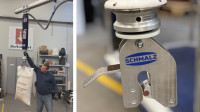Modular belts. Focus on hygiene!
Constantly growing requirements for food safety and its shelf life force food equipment manufacturers to continually search for new technical solutions. Modern equipment should not only perfectly ensure the production of products, but also must comply with the hygienic standards of enterprises.
There are several organizations in Europe that issue recommendations for the design of food processing equipment, taking into account the requirements of HAACP, FDA and other regulatory acts. In Ukraine, these recommendations are not mandatory and each manufacturer decides for himself how much hygienic equipment is a priority.
Conveyors are widely used in every food production. The selection of the transporting element significantly influences the design of the conveyor itself, its cost, its maintenance, methods of carrying out sanitary and hygienic cleaning, the period of downtime needed for cleaning and the labor time of the operating personnel. Therefore, when searching and reviewing technical solutions, it is worth paying attention to the details and choosing the most suitable option for each specific case, taking into account the pros and cons.
Modular belts consist of plastic modules interconnected by plastic or steel pins. The belt is driven into motion by sprockets. The composing design allows to assemble belts of required width and length. Various modules design and a wide range of materials allows to select proper modular belt depending on the product transported, the acidity, temperature, chemical resistance requirements, etc. Some manufacturers add antimicrobial additives to the belt material but not all of them are allowed for use in the food industry.
Modular belts are a good engineering solution for both straight and curved conveyor sections, as well as for spiral conveyors. The ability to combine straight, inclined and curved sections with a single belt allows reducing the number of drives, which affects the efficiency and hygiene of the equipment. For spiral conveyors, modular belt is the optimal solution along with steel mesh belts.

Sanitary-hygienic processing of modular belts is not a simple task, either when it is done manually or with the help of a CIP-wash. The belt must be cleaned carefully, from the top and bottom, so that the remains of the transported product are completely removed between the modules, from the sprockets and guide profiles. If the belt has a closed, impermeable surface, it is required to install a lift unit on the conveyor to enable cleaning.

For effective CIP-washing, the nozzle beam must be installed in such a way that the water flows to the return roller, where the opening of the links takes place in order to completely remove contamination between the links.

If brushes are used for cleaning, the color of the bristles should contrast with the color of the belt as well as with the color of the product. After cleaning, the brushes should be disinfected with a solution or subjected to heat treatment.
About other types of conveyor elements and the feasibility of their use for transporting food read in the next-coming blogs. Ask your questions in the comments.









Comments